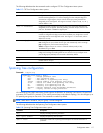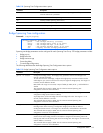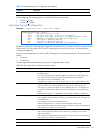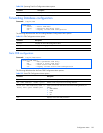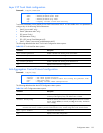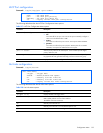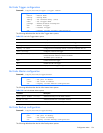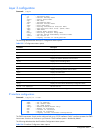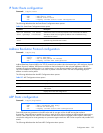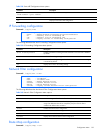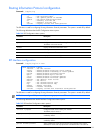
Configuration Menu 125
Table 131 Hot Links Backup Menu options
Command Description
port <port number (17-24)> Adds the selected port to the Backup interface.
trunk <1-12> Adds the selected trunk to the Backup interface.
cur Displays the current Backup configuration.
VLAN configuration
Command: /cfg/l2/vlan <1-4095>
[VLAN 1 Menu]
name - Set VLAN name
stg - Assign VLAN to a Spanning Tree Group
add - Add port to VLAN
rem - Remove port from VLAN
def - Define VLAN as list of ports
ena - Enable VLAN
dis - Disable VLAN
del - Delete VLAN
cur - Display current VLAN configuration
The commands in this menu configure VLAN attributes, change the status of the VLAN, delete the VLAN, and change
the port membership of the VLAN.
By default, the VLAN menu option is disabled except VLAN 1, which is always enabled. The GbE2 Interconnect
Switch supports a maximum of 1,000 VLANs.
NOTE: See the HP ProLiant BL p-Class GbE2 Interconnect Switch Application Guide for information on VLANs.
The following table describes the VLAN Configuration Menu options.
Table 132 VLAN Configuration Menu options
Command Description
name <1-32 characters> Assigns a name to the VLAN or changes the existing name. The default
VLAN name is the first one.
stg <1-32> Assigns a VLAN to a spanning tree group.
add <port number> Adds ports or trunk groups to the VLAN membership.
rem <port number> Removes ports or trunk groups from this VLAN.
def <list of port numbers> Defines which ports are members of this VLAN. Every port must be a
member of at least one VLAN. By default, it defines ports to VLAN 1.
ena Enables this VLAN.
dis Disables this VLAN without removing it from the configuration.
del Deletes this VLAN.
cur Displays the current VLAN configuration.
IMPORTANT: All ports must belong to at least one VLAN. Any port which is removed from a VLAN and which
is not a member of any other VLAN is automatically added to default VLAN #1. You cannot remove a port
from VLAN #1 if the port has no membership in any other VLAN. Also, you cannot add a port to more than
one VLAN unless the port has VLAN tagging turned on. Refer to the tag command, in the “Port configuration”
section earlier in this chapter.



